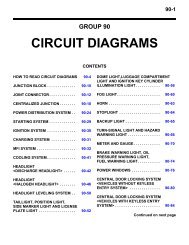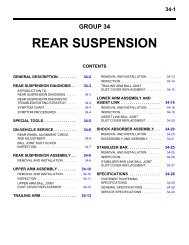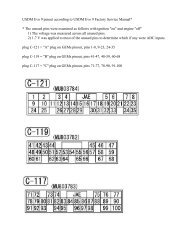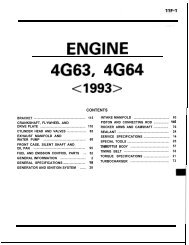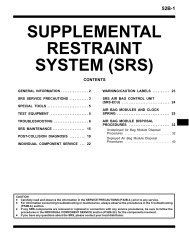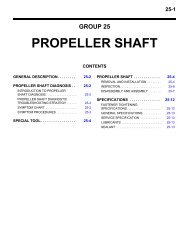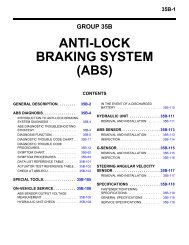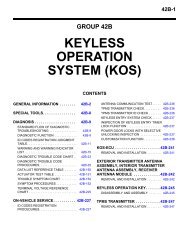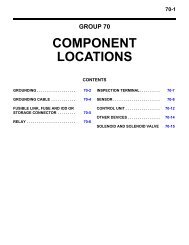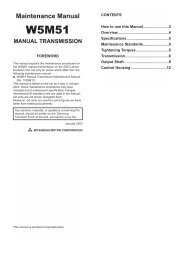Merlins Ralliart and EvoX TUNING GUIDE Version K.pdf - EvoScan
Merlins Ralliart and EvoX TUNING GUIDE Version K.pdf - EvoScan
Merlins Ralliart and EvoX TUNING GUIDE Version K.pdf - EvoScan
- No tags were found...
Create successful ePaper yourself
Turn your PDF publications into a flip-book with our unique Google optimized e-Paper software.
MERLINS RALLIART & EVOLUTION-X <strong>TUNING</strong> <strong>GUIDE</strong>SECTION 5 – IGNITION <strong>TUNING</strong> PART 1 - BASICS5.01-IGNITION <strong>TUNING</strong> INTRODUCTIONAn ideal combustion process behaves in the following manner:1. The air fuel mixture is brought into the combustion chamber. Ideally this mixtureshould have around 12.5:1 AFR to extract maximum power from gasoline. Giventhat the Evo engine has evolved over about 17 years, crappy CA gas, <strong>and</strong> highboost, this ideal is pretty hard to achieve without running water/methanol injection.Most non race/track Evos run between 11.7 <strong>and</strong> 11:3 AFR.2. The intake <strong>and</strong> exhaust valves close <strong>and</strong> the spark plug fires. On an Evo8 a sparkplug fires at around 18-21° BTDC by 7000 rpm. On an Evo9 there is less timingadvance with the spark plug firing around 14-16° BTDC by 7000 rpm. Why lesstiming advance on the Evo9 than the Evo8? In part, it is because the Evo9 isblessed with a better cooled <strong>and</strong> better flowing cylinder head than the Evo8. TheEvo9 can run leaner AFRs. Leaner AFRs burn faster up to 12.5:1. Beyond that theyburn slower. A faster burning mixture does not require as much timing advance asa slower burning one. I am not saying that the Evo9 has a leaner AFR from thefactory. Far from it. What I am saying is that it has the potential to run leaner AFRs<strong>and</strong> consequently less timing advance.3. After the spark is fired the burning of the mixture proceeds. It begins at thespark plug <strong>and</strong> progresses in an orderly fashion across the combustion chamber. Itis as if you took a pebble <strong>and</strong> threw it in a pond <strong>and</strong> watched the ripples progressoutward from where the pebble fell. The burn should be complete with noremaining air-fuel mixture by the end of the combustion process.In reality, combustion sometimes does not progress in an orderly <strong>and</strong> smoothfashion. Sometimes the air-fuel mixture spontaneously combusts after the sparkplug is fired but before the flame front reaches the mixture. This is known asdetonation or knock. Why does that happen? Too much pressure <strong>and</strong> too much heatcombined with a fuel of insufficient octane rating to resist self-combustion. Octaneis a term to describe a property of a fuel, not an actual chemical component in thefuel. Think of octane as the ability of gasoline to resist self-combustion underpressure <strong>and</strong> heat. The higher the octane the less likely the gasoline will selfcombustunder high boost <strong>and</strong> heat that the Evo is known to generate.When a car knocks, it causes a very sharp pressure spike that is outside the normalshape of the pressure curve during normal combustion. The pressure spike createsan abnormal force in the combustion chamber. The engine block will ring in reactionto the force generated from the pressure spike, just as if it had been hit with ahammer. That is where the knock sensor steps in.REV: 0.K merlin@three.com.au Page 43 of 134




